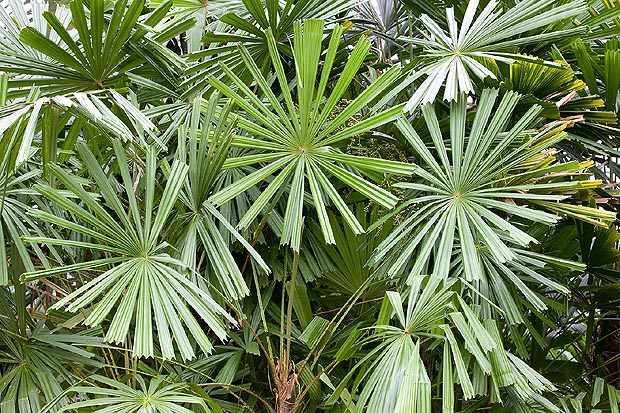Family : Arecaceae

Text © Pietro Puccio

English translation by Mario Beltramini

The Licuala peltata var.peltata has deeply divided leaves whilst in the sumawongii they are entire © G. Mazza
The name of the genus comes from the local name “leko wala”, given to these palms in the Maluku Islands; the name of the species comes from the Latin “peltata” = armed with a pelta (a small and light shield), peltate; in botany with such term they indicate a leaf, usually roundish, having the petiole inserted at the centre or, in any case, inside the lamina.
Common names: salai-pathi (Andaman); chatta-pat (Assamese); kurud, lepcha (Hindi); kapadah, salu (Burmese); ga-por, kajing- kajing, ko ching (Thai) .
The Licuala peltata Roxb. ex Buch. - Ham. (1826) is a solitary plant, rarely caespitose, monoecious, with stems which may even reach the 6 m, but usually lower when cultivated, with a diameter of 10-12 cm, covered from the base by the petioles which remain for quite a long time, but in the oldest part. The glossy, intense green, leaves are palmate, orbicular, 1-2 m long and broad, rarely entire, usually divided up to the base in several cuneiform segments, up to about 1 m long and 5-30 cm broad, with close and diverging nervations, apex truncated and deeply lobed with 4 to 6 lobes even 5 cm long.
The petioles are 1-2 m long and have a green to brownish colour with the margins armed of robust curved thorns, long up to 1 cm; the base, with fibrous brown margins, surrounds the stem only partially. The inflorescences bear between the leaves, are up to 4 m long, arcuate, and are compound spikes, that is to say, formed by a main axis from which depart secondary ramifications (spikelets), pendulous and carrying greenish white hermaphrodite flowers, rich of nectar and perfumed, chiefly pollinated by the bees. The fruits are globular, up to 1,5 cm of diameter, of orange colour and contain one seed only. It reproduces by seed which germinates in 3-4 months with bottom heat; the initial growth is rather slow.
Usually, botanists distinguish two varieties, the Licuala peltata var. peltata, with divided leaf, and the Licuala peltata var. sumawongii, with entire leaf, deemed extinct in the wild, but amply cultivated due to the beauty of its foliage. This plant stands among the greatest of the Licuala, cultivable on soils rich of organic substance and draining, preferably sandy, kept constantly humid, in shaded position and well sheltered from the wind, in particular the variety sumawongii, in the tropical and humid subtropical climate zones. Its cultivation in the warm-temperate zones may be tried, in a particularly sheltered location, as it may resist to temperatures as low as -2 °C for short time, without too many damages to the foliage; in these conditions, the growth is slow, especially if the local humidity is not high.
The position must be shaded or in filtered sunny light and with sufficient room around so as to fully enhance its characteristics. The variety sumawongii is also an appreciated pot plant for the decoration of patios, greenhouses, winter gardens and spacious, little luminous interiors, utilizing substrata rich of organic substance with addition of coarse sand, around the 30%, in order to improve the drainage; the watering must be regular all the year round and the temperatures are good no to go under the +16 °C. Locally, the leaves are utilized for making headgears, whilst the roots are utilized in the traditional medicine as diuretic.
→ For general notions about ARECACEAE please click here.
